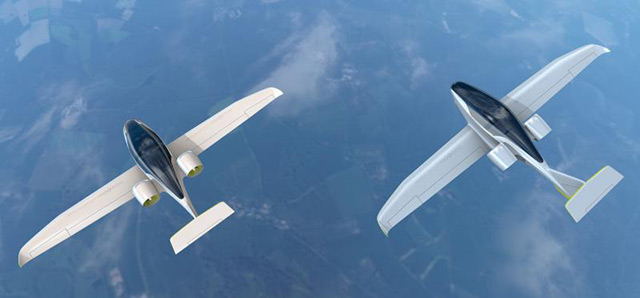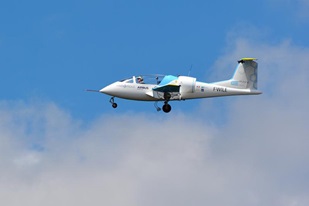
The Comparative Aircraft Flight Efficiency (CAFE) Foundation’s Electric Aircraft Symposium is a small annual gathering, with the sort of originality, enthusiasm, and camaraderie that must have suffused the first meetings of the fledgling Experimental Aircraft Association back in its early days in the 1950s. This year’s ninth symposium, with 170 attendees, was held May 1 and 2, at Santa Rosa, California’s Flamingo Resort. The first symposium, back in 2007, attracted just 15 of the faithful. The electric-aircraft movement has gained momentum since then, and this year’s symposium presentations illustrated examples of continued experimentation and applied theory. It also showed that challenges persist.
Still, the mood was upbeat, and there was no want of ever more ideas, a few of them on the kooky side. The symposium amounts to an international who’s who in electric aviation, and represents the most original thinkers in the field. Here’s a quick rundown of news and notes.
Airbus E-Fan. Ken McKenzie, Airbus’ senior vice president of strategy and corporate development deputy chairman, proved that the European aerospace giant is definitely taking electrically powered designs seriously. He announced that Airbus, together with partner VoltAir SAS, would be building a large final assembly building in Pau, France. The plant will be dedicated to manufacturing the Airbus E-Fan 1.0, an electrically powered twinjet. This airplane, which first flew in public at last year’s Farnborough International Airshow, is scheduled to fly at this year’s EAA AirVenture in Oshkosh, Wisconsin. The E-Fan 1.0 is strictly a demonstrator and a testbed airplane, dedicated to systems analysis. Its max takeoff weight is 1,433 pounds, its max cruise speed is 86 knots, and its landing speed is 60 knots.

A follow-on design, the E-Fan 2.0, is a two-seat trainer for the European market. Its entry into service is set for 2017. Meanwhile, the E-Fan 4.0 is aimed at the American market as a four-seat training and touring airplane. It will be certified to FAR Part 23 certification standards, Airbus said, and McKenzie said Airbus will use VoltAir’s U.S. subsidiary to build a new construction facility for the 4.0 in the United States, although he wouldn’t say where. A $60 million project, McKenzie said the 4.0 will have an “overall price that’s better than other airplanes in this market segment.” First deliveries should be in 2018, although record flights in Europe using a prototype should occur in the coming months.
SolarStratos. Designer Calin Gologan of Germany’s PC-Aero explained his latest collaborative project, the SolarStratos, which is designed for research flights to altitudes as high as 80,000 feet. The pilot will have to wear a pressure suit, but even so the airplane’s emergency descent time may become an issue. It’s expected to become operational in 2017.
Sunseeker Duo. Famed designer Eric Raymond reviewed his most recent long-distance flights in his two-seat, solar-electric powered SunSeeker Duo. Raymond, a designer of the Solar Impulse, Solar Challenger, and other historic airplanes, has flown the Duo across the Alps and is planning another long cross-country flight, from California to Patagonia.
Launchpoint Technologies’ Michael Ricci delved into the regulatory hurdles facing electrically powered aircraft. That’s saying a lot. In the United States, there is no certification pathway for electrically powered aircraft—except as an experimental aircraft. This rules out instructional flying and rentals. There is no path for LSA certification of electric aircraft, and so far FAR Part 23 has no provisions for electric propulsion. American authorities have near-zero familiarity with electrically powered aircraft, and so the regulatory culture remains frozen in place. The issue seems to be the question of engine failure rates and modes. Ricci postulated that electrical motors have one-in-a-million chances of failures in any given flight hour, whereas piston engines have 1-in-10,000-hour shutdown rates. Fault-tolerant computing and built-in test equipment (BITE) are methods that could help ensure safe operation, Ricci said. That, and redundant digital controllers of the sort used in large, fly-by-wire airplanes. Of course, this in turn means more sensors and more software and hardware—and more weight.
George Bye, director of the Sun Flyer project, explained that his Colorado company has been successfully pursuing certification under FAR Part 21.17 (b)—Very Light Airplanes—through the Chicago and Kansas City ACOs. The Sun Flyer now exists as a re-branded version of PC-Aero’s Elektra One, and is a single-seat proof-of-concept demonstrator under license from Gologan’s PC-Aero. The slippery trainer may soon be fitted with flaps. Redbird Flight Simulations is building a simulator for use with the Sun Flyer, and PC-Aero is set to deliver a two-seater later this year. The Sun Flyer should be on display at EAA AirVenture this year, Bye said, and its price is projected to be $200,000. However, based on 800 flight hours per year in a training environment, annual maintenance cost of a Sun Flyer should be just $1,000, whereas a Cessna 172’s costs run about $6,000, Bye emphasized.
NASA-Johnson’s Dr. Eric Darcy addressed the issue of lithium-ion battery thermal runways—another major stumbling block to public acceptance. The answer to minimize fire danger? Separate battery cells with heat-spreading material interspersed between them, use vents and fans to keep heat down, and surround the cells with foam supports to prevent breakage of cell sidewalls.
Zachary Favors of research and development firm ZAF Energy Systems outlined alternatives to lithium-ion battery technology. One is to use a zinc-air medium, which could produce twice as much power and range as lithium-ion technology. Another would use silicon derived from beach sand. But new, more energy-dense technology is an elusive goal and it may be years before zinc-air technology is fully realized, Favors said.
Autonomous flying got a lot of attention at the meeting. Pilotless electric vehicles with vertical, or extremely short takeoff and landing, capabilities, could be programmed to deliver passengers and payloads with precision and safety, given GPS and Lidar technologies, it was argued. CAFE Foundation founder Dr. Brien Seeley advanced a “Sky Transit” concept that would use small “pocket airparks” established on rooftops or small open areas, thus freeing up the asphalt “hardscape” required by automobiles and airplanes. Tyler MacCready, president of Ocean Lab, proposed that an algorithm based on observations of bird flocking and “swarm science” could lead to safe, collision-free autonomous flight.
Seeley concluded by proposing a second Green Flight Challenge, one that would grant $2 million in prizes to those who could develop a quiet, extremely short takeoff and landing, electrically powered, autonomously flown vehicle that could serve as a prototype for the Sky Transit concept. To win the prize, competing aircraft must clear both three-foot and a 30-foot obstacles after takeoff, all the while meeting or beating sideline noise limits. The contest would take place within an aviary-type structure and vehicles must take off at 10-second intervals, and then land gently—as determined by G-meters. Rotor diameter or wingspan can’t exceed 44 feet, the max takeoff weight limit is 1,322 pounds, and payload will be 661 pounds. The CAFE Foundation posted a petition for attendees to sign. The petition will be sent to the U.S. Departemnt of Transportation and Federal Aviation Administration, asking for their support of the Sky Transit grant as a means to help bring about eco-friendly, and less congested, public transportation.



